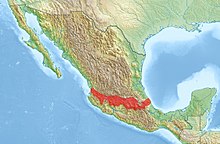Sierra Nevada (Mexico)
| Trans-Mexican Volcanic Belt Stratigraphic range: Neogene to Quaternary |
|
|---|---|

Six Mexican Volcanoes
Left to right Ixtaccíhuatl, Popocatépetl, Matlalcueitl (Malinche), Cofre de Perote (most distant), Pico de Orizaba, Sierra Negra |
|
| Type | Volcanic Arc |
| Overlies | Sierra Madre Occidental |
| Area | 160,000 kilometres (99,000 mi)2 |
| Thickness |
East of 101°W 50-55 km West of 101°W 35-40 km |
| Location | |
| Coordinates | 19°02′N 97°16′W / 19.03°N 97.27°W. |
| Region | Central Mexico |
| Country | Mexico |
| Extent | 1,000 kilometres (620 mi) |
 |
|
East of 101°W 50-55 km
The Trans-Mexican Volcanic Belt (Eje Volcánico Transversal), also known as the Transvolcanic Belt and locally as the Sierra Nevada (Snowy Mountain Range), is a volcanic belt that covers central-southern Mexico. Several of its highest peaks have snow all year long, and during clear weather, they are visible to a large percentage of those who live on the many high plateaus from which these volcanoes rise.
The Trans-Mexican Volcanic Belt spans across Central-Southern Mexico from the Pacific Ocean to the Gulf of Mexico between 18°30'N and 21°30'N, resting on the southern edge of the North American Plate. This approximately 1000 kilometer long, 90–230 km broad structure is an east-west, active, continental volcanic arc; encompassing an area of approximately 160,000 km2. Over several million years, the subduction of the Rivera and Cocos plates beneath the North American Plate along the northern end of the Middle America Trench formed the Trans-Mexican Volcanic Belt. The Trans-Mexican Volcanic Belt is a unique volcanic belt; it is not parallel to the Middle American Trench, and many of the main stratovolcanoes are positioned obliquely to the general position of the arc. In addition to the physiographic complexities, igneous compositions vary—dominant subduction related products contrast with intraplate geo-chemical signatures. The many intriguing aspects of the belt has spurred several hypotheses based on a typical subduction scenario; Intra-plate leaky transform faults, mantle plumes, continental rifting, and jump of the eastward Pacific Rise. These features are partially related to the reactivation of early fault systems during the Trans-Mexican Volcanic belt's evolution. The main brittle fault system's geometry, kinematics, and age define a complex array of what could be multiple factors affecting the deformation of the belt. It exhibits many volcanic features, not limited to large stratovolcanoes, including monogenetic volcano cones, shield volcanoes, lava dome complexes, and major calderas.
...
Wikipedia
